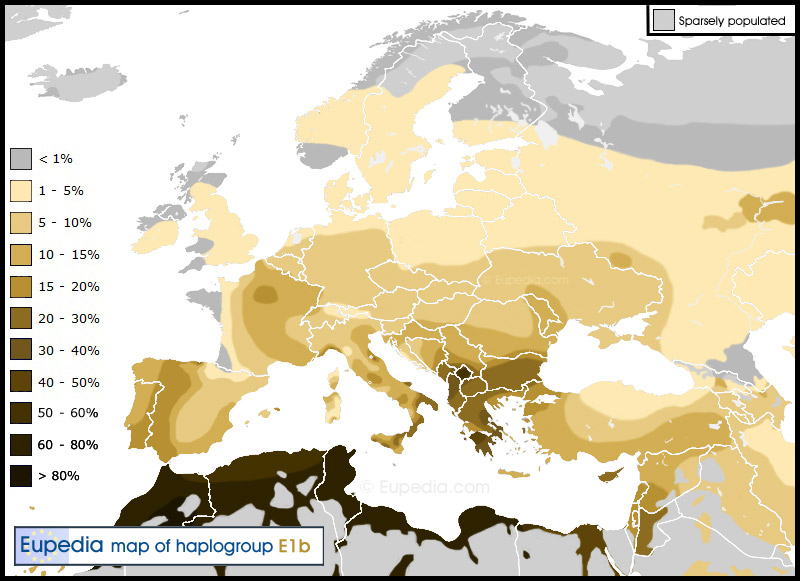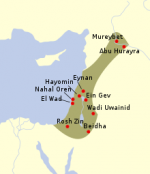Templar
Regular Member
- Messages
- 590
- Reaction score
- 49
- Points
- 0
- Ethnic group
- Paleolithic European
- Y-DNA haplogroup
- G-L42
- mtDNA haplogroup
- H2a1
Sounds like Hungarian cheap propaganda.
I never said I supported the theory
Follow along with the video below to see how to install our site as a web app on your home screen.

Note: This feature currently requires accessing the site using the built-in Safari browser.
Sounds like Hungarian cheap propaganda.
Hi,
very interesting theory from all of you, but how do you think I can seek my roots, in Romania?
Grigoris
I think the bulk of albanian history is a mystery, they have no written records. Outside sources are very sparse, I do not proclaim them to be illyrians either, not enough info to declare anything as fact. I think they obviously have some illyrian in them but so does every other balkan nation.
I have heard wild claims from nationalists there that are laughable at best. I think anything related to any balkan countries needs to have various sources from more then one country to be verified due to everyone hating everyone else there.
The amount of haplogroup differentiation between Balkan populations is insignificant making the study of specific subclades most useful. If Albanians are in fact predominantly Illyrian then E1b1b (27.5% in Albanians) may indicate Illyrian descent as we find high frequencies of this marker in all Balkan peoples even Bulgarians (16%) whom we know migrated to the Balkans in the 6th century AD. The highest frequencies are found along the Western side of the Balkan peninsular. The highest frequency of E1b1b is found in central Greece (29.5%) with southern Greece not far off (27%). However, this marker is found in 23% of modern Macedonians and 20.5% of modern Serbs. The East has markedly less E1b1b which makes sense if you look at where ancient Illyrian settlements were concentrated.
Dienekes calculated the relative ages of E1b1b in various Balkan communities:
N Age (25y/gen) Age (30y/gen)
Nea Nikomedeia 8 149 1725 BC 2470 BC
Sesklo/Dimini 20 71 225 AD 130 BC
Lerna Franchthi 20 120 1000 BC 1600 BC
Crete 13 68 300 AD 40 BC
Haplozone 103 134 1350 BC 2020 BC
Aromuns (12) 32 71 225 AD 130 BC
Aromuns (8) 32 73 175 AD 190 BC
Slavomacedonians (12) 13 51 725 AD 470 AD
Slavomacedonians (8) 13 59 525 AD 230 AD
Albanians (12) 9 70 250 AD 100 BC
Albanians (8) 9 59 525 AD 230 AD
From these findings it would appear the E1b1b is a relatively young Albanian marker and was first established in the region of Central Macedonia in Greece.
http://dienekes.blogspot.com/2008/07/expansion-of-e-v13-explained.html

The hotspot of E1b1b in Albanians from Kosova and Albania could well be as a consequence of genetic drift from a relatively recent introduction into the area (c.100BC) from ancient Macedonia, Greece.
so them being derived from Greeks is Dienekes bullshit just as his Anatolian hypothesis of Indo-European origins.
Some Illyrian?You are a funny guy.Most of you Balkan Slavs are the most annoying groups in internet.You never fail to bring up this Illyrian thing among Albanians.Albanians should in no way be compared to Balkan Slavs in term of native ancestry.Reasons?We speak a Paleo-Balkan language.Preservance of language means better preservance of genes too.Speaking about myths.Isn't your people who have spread the nonsense that I2a2-Din was the major Illyrian haplogroup and 10 thousand years old in Balkans(which obviously reflects the Slavic expansion) and similar bullshit propaganda?Ofcourse yes but you are pointing the finger toward Albanians because of your huge inferiority complexes.
Albanians being descendants of Illyrians is not based on myths but on facts.Despite the whole genetic linguistic and historical facts you still are stubborn to aknowledge this.Albanians derive their name from the Illyrian tribe of Albanoi or it's original name being Arber(meaning gold makers in Albanian).Not to mentions dozens of other evidences but it will be offtopic and you would not aknowledge anyway.
All of EV13 in Balkans is due to genetic drift.The paragroup of EV13 EM78* was found among two Albanians so them being derived from Greeks is Dienekes bullshit just as his Anatolian hypothesis of Indo-European origins.
EV13 was found in Neolithic Spain i guess Greeks were responsible for it's spread there lol.
The spread of EV13 in Balkans reflects a Western Balkans to Eastern Balkans spread.The highest diversity in one study was found in Bosnia.So much of your Greek EV13.
R1b Indo-Europeans DID come from Anatolia, while R1a ones came from the Central Asian Steppe/Eastern Ukraine.
^lol.EV-13 were either late Mesolithic people or early Neolithic farmers.EV-13 were not proto Illyrians or proto-Albanian people they were early Balkan people who got assimilated from proto-Illyrians who came from Central Europe.Also,EV-13 makes 45% of overall Albanian Y-DNA among Albanians in Kosovo and ~30% among Albanians from Albania.So EV13=/=Albanian since R1b and J2b2 are major Albanian haplogroups too,the R1b being more present in Kosovo ranging from 21-25% while J2 being more present in Albania.Ev13 is just the most common because of founder effect like in all Balkan countries.
The rest of your post is total crap and unscientific.
R1b did come from Anatolia but they were not Proto Indo-European for sure.It seems that this paternal lineage is connected with Bell Beaker culture which was late Neolithic comer and started from Southern Portugal.R1b or more specifically some subclades of R1b got Indo-Europeanized in Central Europe where they also acquired more Northern autosomal admix through swapping women with Corded Ware people.
Maybe R1b U152 was the Italic-Celtic marker?
http://openlearn.open.ac.uk/file.php/4470/!via/oucontent/course/9476/gaelic_1_fig008.jpg
http://compsoc.nuigalway.ie/~dubhthach/U152-S28-poE-CT.png
Apparently R1b U152 is most diverse in Western Poland.
E-V13 is not founder effect in Balkans
Iberia is very far where we have Mesolithic E Hg from tombs/bones
Balkanic E-V13 is relative to Cyprus Levant
(Kadmeian-Pelasgian most possible or Phoenician)
possible entrance to Balkans is Peloponese during chalkolithic era
considering Homer we see the word Αιθιοψ.
Ethiopeia is probably mother Land of Balcanic E-V13 but probably came from Cyprus
since Akkado-Cyprus knew and had unlimited copper
by what I remember the highest peaks are in Greece and not in Albania (where are highest numbers) and mainly in areas were Achaians settled and not Arbanites,
E-V13 drops to Arberesh and Arbanites (correct me if I am wrong) and in many other Greek populations.
I even hear and read that E-V13 could come from liberation of slaves or Roman armies or Ottoman armies but I don't think so
I guess genetics soon will drop more light
Yes it is.Balkans lacks diversity.All of EV-13 is from a single subclade.
Did they found out the Y-DNA of Mesolithic Iberians?Can you link the study?You cannot.Because they didn't test the Y-DNA.
Why do some people resort themself in mythology and make wild guesses concerning haplogroups?Stop this nonsense please.
Archeologically there is a link of Pelasgians with Anatolian people.So we can link them with Anatolian Neolithic invaders who were full of J2a and/or J2b and possible R1b L23+.
Now we have nothing in hand regarding of how EV-13 came to Balkans.It has been found in Neolithic side in Iberia alongside the dominating G2a males of Cardium Pottery Culture.
Now either the G2a Middle Eastern Neolithic people already found the EV13 in Southern Europe who came in late Mesolithic times or EV-13 was in minority alongside the G2a people.
There is a upcoming aDNA study concerning the Balkan Neolithics.Probably we will find answers of our questions.
That is true not only one but many
it seems results in balkans by older search seems to be not satisfiying
the thing you know and probably hide since you the Iberian E-V13 is that another Mark of Balkanic
Balkanic is Kushetic and Iberian is North West African. may be I am worng but one is M-79 and the other M-81
maybe I am wrong, but I think that is the situation,
The Balkanic E I think is same with Cyprus and Levant and Phoenicia, and has nothing to do with modern ethnicities in Balkans, but with older
so your in post number #45 where you consider E-V13 as Albanian is accurate?
remember Hommer describes people in Troyan war as Ethiops Αιθιοψ so he knew that Egypt Ethiopean people came to Mycenes,
and I am certain that you don't believe when he describes Ethiops he meant Albanian

All of EV13 in Balkans is due to genetic drift.The paragroup of EV13 EM78* was found among two Albanians so them being derived from Greeks is Dienekes bullshit just as his Anatolian hypothesis of Indo-European origins.
EV13 was found in Neolithic Spain i guess Greeks were responsible for it's spread there lol.
The spread of EV13 in Balkans reflects a Western Balkans to Eastern Balkans spread.The highest diversity in one study was found in Bosnia.So much of your Greek EV13.
Yes it is.Balkans lacks diversity.All of EV-13 is from a single subclade.
Did they found out the Y-DNA of Mesolithic Iberians?Can you link the study?You cannot.Because they didn't test the Y-DNA.
Why do some people resort themself in mythology and make wild guesses concerning haplogroups?Stop this nonsense please.
Archeologically there is a link of Pelasgians with Anatolian people.So we can link them with Anatolian Neolithic invaders who were full of J2a and/or J2b and possible R1b L23+.
Now we have nothing in hand regarding of how EV-13 came to Balkans.It has been found in Neolithic side in Iberia alongside the dominating G2a males of Cardium Pottery Culture.
Now either the G2a Middle Eastern Neolithic people already found the EV13 in Southern Europe who came in late Mesolithic times or EV-13 was in minority alongside the G2a people.
There is a upcoming aDNA study concerning the Balkan Neolithics.Probably we will find answers of our questions.
lol i cannot believe you are so ignorant.There is so much bullshit in your post that i don't know were to start.
The EV-13 in Iberia was EV-13 not E-M81 Berber clade.
And EV-13 is not a Balkanic marker.It just peaks in Balkans because of founder effect.
Druzes in Levant region have this marker too.It could well be a Natufian marker.
View attachment 5694
And please improve your grammar skills.I cannot follow your logic.
Y-DNA haplogroups from Romania(Cluj,Brasov,Dolj,Mehedinti counties,aslo Basarab surnames)
If you noticed the most mixed nation (by haplogroups) are romanians from Romania. Moldovans got two main haplos R1a and I (mostly I2a but also I1). At least 70% of moldovans are romanian-speaking. As I said romanians are the most mixed, granted to that we got a lot of surnames wich reflects nations' names as you can see below:
1. Rusu (the most spread) (Russian)
2. Ungurean(u) (Hungarian)
3. Sirbu (Serb)
4. Moldovan(u)
5. Grecu (Greek)
7. Bulgar(u) (Bulgarian)
8. Neamtu, Nemtanu (German)
9. Tintar(u) (Aromanian)
10. Vlah(u) (Vlach or Romanian from Walachia)
11. Ardeleanu (Transylvanian)
12. Arnaut(u) (Albanian)
13. Horvat (Croat)
14. Leahu (Pole)
I'm sure that Romanian nation emerged in the same way as American, Canadian or Australian and it happened when Latin (ancient Romanian) was the most spoken language
If you noticed the most mixed nation (by haplogroups) are romanians from Romania. Moldovans got two main haplos R1a and I (mostly I2a but also I1). At least 70% of moldovans are romanian-speaking. As I said romanians are the most mixed, granted to that we got a lot of surnames wich reflects nations' names as you can see below:
1. Rusu (the most spread) (Russian)
2. Ungurean(u) (Hungarian)
3. Sirbu (Serb)
4. Moldovan(u)
5. Grecu (Greek)
7. Bulgar(u) (Bulgarian)
8. Neamtu, Nemtanu (German)
9. Tintar(u) (Aromanian)
10. Vlah(u) (Vlach or Romanian from Walachia)
11. Ardeleanu (Transylvanian)
12. Arnaut(u) (Albanian)
13. Horvat (Croat)
14. Leahu (Pole)
I'm sure that Romanian nation emerged in the same way as American, Canadian or Australian and it happened when Latin (ancient Romanian) was the most spoken language
This is a concise presentation of my views on history.
This thread has been viewed 485187 times.
